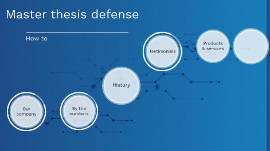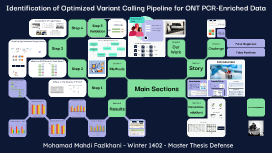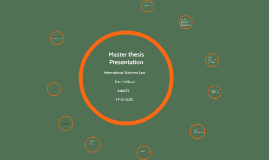Master Thesis Defense
Transcript: 10 ' 5 putative lipolytic clones 10E2, 12C11, 14G2, 16G7 and 35H9 http://www.iml.rwth-aachen.de/index.php?id=rotes-meer A A p-nitrophenol 348 nm Thank You Introduction Materials and Methods Results and Discussion Conclusion and Future prospects Acknowledgements Inactive A p-nitrophenylbutyrate (C4) Culture supernatant Tris-HCL (pH 8.0) Sequencing and ORF detection Mining for novel biocatalysts from metagenomes Screening Metagenomic Library for Lipolytic Activity Further characterization of EstATII is required to understand its full potential as a biocatalyst (solvents, heavy metals, enantio- and regioselectivity, expand on substrate specificity). Cloning into an expression vector, followed by over-expression and purification. By Yasmine M. Mohamed Under the supervision of Dr. Rania Siam A Tributyrin agar 37°C 3 days Based on BLASTP analysis and domain search: EstATII is a putative novel lipolytic enzyme p-nitrophenol 410 nm End-repair and A tailing Dr. Rania Siam Dr. Mohamed Ghazy Dr. Ahmed Sayed Mr. Amged Ouf Mr. Hazem Sharaf Dr. Ari Ferreira Dr. Felipe Chambergo Dr. Hamza Al Dorry KAUST Al Alfi Foundation Friends from the Biotechnology Program and specially Rehab Abdallah Lamyaa Shaban Sara Al-alawi Ibrahim Farag Tamer Said Ayman Yehya Applications Atlantis II Deep Hydrolysis Leather Manufacture Waste Treatment Detergents Pulp and Paper Industry Ester Synthesis Pharmaceuticals and cosmetics Biopolymers Biodiesel Transformation 10 minutes Effect of NaCl on EstATII activity Traditionally, biocatalysts were obtained from pure microbial isolates. Less than 1% of microorganisms can be accessed through culture-dependant approaches. A huge potential lies within the majority of the prokaryotic community that is unculturable. p-nitrophenylbutyrate Signal Peptide Detection p-nitrophenylbutyrate Manually placed into 96-well plates Temperature pH NaCl Substrate Specificity p-nitrophenyl palmitate (C16) p-nitrophenylpalmitate (C16) Sample collection and DNA isolation 0.78 0.713 0.72 Mean= 0.737 Dedication Effect of pH on EstATII activity My Family Mohamed Abouelsoud Confirmed by PCR and Sequencing http://www.chemnet.com/dict/dict--1492-30-4--jp.html Pyrosequencing and ORF detection The largest brine pool in the Red Sea and has a maximum depth of 2,194 m and has the highest temperature. Stratified into several layers; the brine-seawater interface, upper convective (UCL), middle convective (MCL) and lower convective layers (LCL). A Continuous demand for novel biocatalysts 10 minutes Culture supernatant Tris-HCl (pH= 8.0) Construction of Phylogenetic Tree 1. Exploring the diversity of microbial communities 2. Discovering novel genes, bioactive compounds and biocatalysts. Characterization of EstATII Substrate Specificity of EstATII MATERIALS AND METHODS Conserved three- dimensional structure A A EstATII Enantio- selectivity Sequence Analysis of EstATII Culture supernatant Tris-HCl (ph=8.0) http://www.cbs.dtu.dk/services/SignalP/ Metagenomics p-nitrophenyl butyrate (C4) The LCL is characterized by Temperature of 68.2°C. pH value of 5.3. Salinity of 270 psu Anoxia. High concentrations of heavy metals. Conserved motifs in the HSL Family Characterization of EstATII revealed: Its thermophilic and halophilic properties which reflect the environment from which it was isolated. It is an esterase not a lipase. Characterization of EstATII Phylogenetic Analysis of EstATII 3'- TC TGG CTG AGC CAT TCG ACT -5' (EstR) Functional Screening for Lipolytic Clones Construction and Screening of Metagenomic Fosmid Library Visualization of Phylogenetic Tree A p-nitrophenol 410 nm http://commonfund.nih.gov/hmp/ Molar concentrations tested: 0M, 0.5M, 1M, 2M, 3M and 4M Ligation Active p-nitrophenol 410 nm http://www.genome.jp/tools-bin/clustalw#clustalw.dnd Substrate Specificity http://asgpb.mhpcc.hawaii.edu/sequence/ http://krse.kaust.edu.sa/mission.html Effect of NaCl Concentration on EstATII Activity Multiple Sequence Alignment http://www.megasoftware.net/ Mining the Atlantis II Deep for Lipolytic Enzymes Effect of pH on EstATII Activity http://www.ncbi.nlm.nih.gov/Structure/cdd/wrpsb.cgi A Family IV: HSL EstATII is a novel esterase isolated from the Atlantis II brine pool. It has thermophilic and halophilic properties. Extreme environments hold great potential for the discovery of novel biocatalysts. Catalytic triad p-nitrophenylbutyrate http://pt.wikipedia.org/wiki/Ficheiro:DNA_ORF.gif 10 minutes Shearing (cc) image by anemoneprojectors on Flickr A Identification and Characterization of a novel thermohalophilic esterase from the Red Sea; the Atlantis II brine pool 0.013 0.015 0.008 Mean= 0.012 A http://www.chemnet.com/dict/dict--1492-30-4--jp.html Identification and Subcloning of Fosmid Harboring EstATII Classification of bacterial lipolytic enzymes into eight families by Arpigny and Jaeger, 1999. Regio- selectivity http://itol.embl.de/ 111 96-well plates 10,656 clones Sequence and Phylogentic Analysis A

















